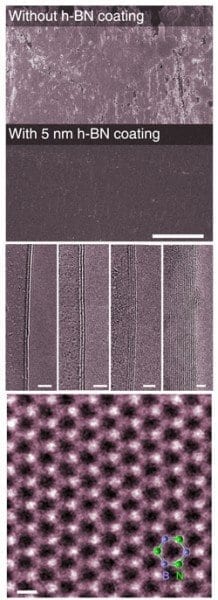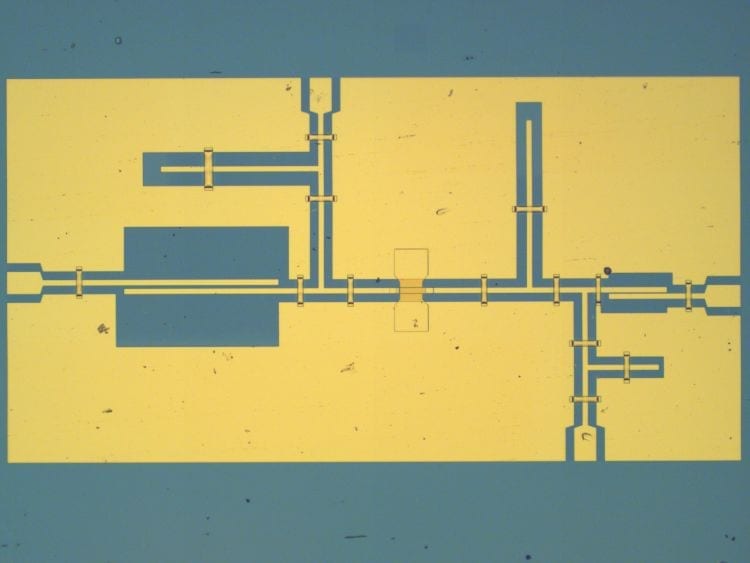
Rice U. researchers find nano-thin films of hexagonal boron nitride protect materials from oxidizing
Atomically thin sheets of hexagonal boron nitride (h-BN) have the handy benefit of protecting what’s underneath from oxidizing even at very high temperatures, Rice University researchers have discovered.
One or several layers of the material sometimes called “white graphene” keep materials from oxidizing – or rusting — up to 1,100 degrees Celsius (2,012 degrees Fahrenheit), and can be made large enough for industrial applications, they said.
The Rice study led by materials scientists Pulickel Ajayan and Jun Lou appears in the online journal Nature Communications.
Oxidation prevention is already big business, but no products available now work on the scale of what the Rice lab is proposing. The researchers see potential for very large sheets of h-BN only a few atoms thick made by scalable vapor deposition methods.
“We think this opens up new opportunities for two-dimensional material,” said Lou, an associate professor of mechanical engineering and materials science. “Everybody has been talking about these materials for electronic or photonic devices, but if this can be realized on a large scale, it’s going to cover a broad spectrum of applications.”
Lou said ultrathin h-BN protection might find a place in turbines, jet engines, oil exploration or underwater or other harsh environments where minimal size and weight would be an advantage, though wear and abrasion could become an issue and optimum thicknesses need to be worked out for specific applications.
The Latest Bing News on:
White graphene
- Wonder Material 'More Remarkable' Than Graphene Has Medical Potentialon May 7, 2024 at 8:55 am
Borophene is already thinner and more conductive than graphene, and scientists have altered it to make it even more special.
- Finnlines Adopts Graphene-based Hard Foul Release Hull Coatingon May 7, 2024 at 8:30 am
Finnlines has turned to a innovative graphene-based hard foul release hull coating to reduce fuel consumption and emissions ...
- Graphene in Biomedicine: Opportunities and Challengeson May 5, 2024 at 5:00 pm
Graphene, whose discovery won the 2010 Nobel Prize in physics, has been a shining star in the material science in the past few years. Owing to its interesting electrical, optical, mechanical and ...
- Graphene Manufacturing Group Ltd GMGMFon May 1, 2024 at 5:00 pm
Morningstar Quantitative Ratings for Stocks are generated using an algorithm that compares companies that are not under analyst coverage to peer companies that do receive analyst-driven ratings ...
- Graphene Manufacturing Group Ltd GMGon May 1, 2024 at 5:00 pm
Morningstar Quantitative Ratings for Stocks are generated using an algorithm that compares companies that are not under analyst coverage to peer companies that do receive analyst-driven ratings ...
- The Flash Pro Plus gives you a power supply anywhere for only $199.97on April 27, 2024 at 7:00 am
TL;DR: Need to charge on the go? The Flash Pro Plus, a graphene power bank powered by Panasonic™, makes it easy to charge your Apple and Android devices anywhere. It’s now only $199.97 ...
- Wafer-thin, stretchy and strong as steel: could ‘miracle’ material graphene finally transform our world?on April 13, 2024 at 6:30 pm
They called it graphene. Consisting of a single layer of carbon atoms arranged in a hexagonal pattern, it is one of the strongest materials ever made and, for good measure, it is a better ...
- Advancing biomedical diagnostics: Graphene sensor inks pave the way for precision biosensingon April 10, 2024 at 5:00 pm
Haydale began working with Cardiff University in 2021, specifically the Wales Kidney Research Unit (WKRU), to create a prototype biosensor using its functionalised biomedical sensor inks.
- Origin of the energy bandgap in epitaxial grapheneon February 19, 2024 at 10:13 am
in the preceding comment to account for the energy gap reported by us 1 in epitaxial graphene on 6H-SiC is unfounded. In our view, the effects of modulations on the lateral structure of graphene ...
- $1 Graphene Sensor Identifies Safe Wateron August 29, 2023 at 7:28 pm
Scientists have reported a graphene sensor they say costs a buck and can detect dangerous bacteria and heavy metals in drinking water. The sensor uses a GFET — a graphene-based field effect ...
The Latest Google Headlines on:
White graphene
[google_news title=”” keyword=”White graphene” num_posts=”10″ blurb_length=”0″ show_thumb=”left”]
The Latest Bing News on:
Oxidation prevention
- Wine Experts Reveal The Biggest Myths That Ruin Good Wineon May 9, 2024 at 12:00 am
Someone gives you a good bottle of red wine, and you decide to store it in the closet for the day you finally retire. Or you’re at a party and someone hands you a bottle of Champagne, so you give it a ...
- Oxidation: Leading Cause of Thermal Fluid Replacement Recommendationson May 7, 2024 at 10:02 am
Use precise geolocation data and actively scan device characteristics for identification. This is done to store and access information on a device and to provide personalised ads and content, ad and ...
- Dehydration program sets local food bank aparton May 6, 2024 at 4:01 am
We’re able to take either donated or purchased fruit and turn it into nutritious snacks that are shelf stable.
- Onsite PFAS Destruction: Understanding Electrochemical Oxidationon April 30, 2024 at 12:49 pm
As the need for PFAS treatment continues to emerge, landfills and waste management facilities can rely on electrochemical oxidation as a proven option for ...
- This Is How Restaurants Keep Avocados Fresh, According To A Chefon April 30, 2024 at 7:00 am
"The best trick to prevent avocados from turning brown," she said, "is to use them!" Rather than trying to prevent oxidation, simply turn them into purées and dressings. Manalang reveals how to make ...
- Clogged Heart Arteries Ayurvedic Remedies: 7 Herbal Drinks That Can Help Flush Out Cholesterol And Prevent Strokeon April 30, 2024 at 12:28 am
Ayurvedic cures take a big picture look towards dealing with blocked heart arteries. Read on to know how you can naturally unclog blocked heart arteries with herbal Ayurvedic drinks.
- 18 Brilliant Uses for Clear Nail Polish That Are Guaranteed to Make Your Life Easieron April 25, 2024 at 7:54 am
Have a bottle of clear nail polish sitting in your medicine cabinet? You'd be surprised at the brilliant uses for clear nail polish that can help make your life easier. From reattaching a button to ...
- Natural obesity fighters: How coffee, tea, and cocoa combat weight gainon April 22, 2024 at 7:03 pm
A review in Current Research in Food Science explores how bioactive compounds in coffee, tea, and cocoa combat obesity by inhibiting white adipogenesis and promoting brown adipogenesis and lipolysis.
- The Safest Way to Store Cut Avocados and Prevent Them From Browningon January 31, 2024 at 4:00 pm
Citrus juice can also keep your bowl of guacamole from browning by preventing oxidation, per a past study, which found that onions have a similar effect. If you have leftover guacamole ...
- Oxidation reactions in foodon October 14, 2014 at 5:54 pm
Antioxidants are molecules that play an important role in preventing our food from spoiling too quickly by stopping oxidation reactions from taking place. The antioxidant molecules are reducing ...
The Latest Google Headlines on:
Oxidation prevention
[google_news title=”” keyword=”oxidation prevention” num_posts=”10″ blurb_length=”0″ show_thumb=”left”]










